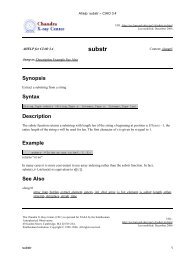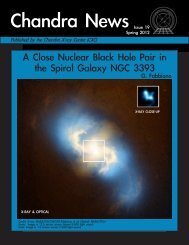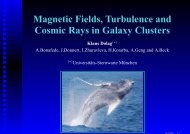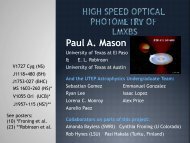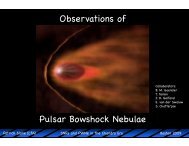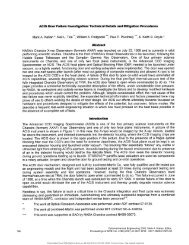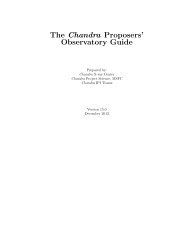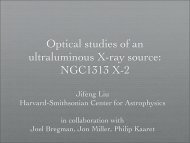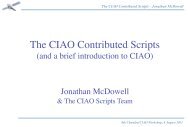Paper Title - Chandra X-Ray Observatory (CXC)
Paper Title - Chandra X-Ray Observatory (CXC)
Paper Title - Chandra X-Ray Observatory (CXC)
Create successful ePaper yourself
Turn your PDF publications into a flip-book with our unique Google optimized e-Paper software.
provide opportunities to confirm the vehicle state of health, to uplink new command products and to dump<br />
the data stored on the SSR to the ground.<br />
1.2. Constraints<br />
Each instrument and subsystem has rules by which it must be operated. Furthermore, there are system level<br />
rules designed to protect the vehicle as a whole. Before launch these rules were documented in a<br />
constraints and restrictions document (CARD). With on-orbit experience some of the constraints in the<br />
CARD could be relaxed or eliminated. As the vehicle has aged new constraints have become necessary.<br />
Since not all vehicle constraints impact mission scheduling and since the CARD was designed for<br />
engineers, not schedulers, a second constraint document, the Mission Planning Guidelines, was created<br />
several years into the mission. This document provides the schedulers with a prioritized list of the rules and<br />
implementations they must make their scheduling decisions by. It is a living document and is frequently<br />
updated. To improve flexibility and accessibility the Mission Planning Guidelines have been recently<br />
ported from a single document into a TWiki web. The Revision Control System built into TWiki provides<br />
adequate configuration management for a controlled document. The TWiki web, hosted on the <strong>Chandra</strong><br />
Operations Control Center (OCC) website, allows linking between the guidelines, the CARD, and reference<br />
materials and provides a widely accessible, platform independent means for viewing the guidelines. The<br />
guidelines are now the primary source for information on vehicle constraints that impact scheduling.<br />
Although one generally thinks of constraints as flight rules for the spacecraft, they are not limited to how<br />
the vehicle is operated. In that each observation has specified parameters that determine how it is<br />
scheduled; each observation is itself a set of constraints. Some observations only define where the vehicle<br />
must point, for how long and which SI must be used. Other observations have exact timing constraints, roll<br />
angle requirements, or coordinations. Constraints that restrict how and when an observation is scheduled<br />
are specified in the same OR that defines the pointing and instrument configuration for the observation.<br />
The combination of vehicle and observation constraints creates a constraint space, which is constantly<br />
evolving. Thermal constraints change with time and with season, the radiation zones evolve with the orbit,<br />
restrictions on use of consumables become increasingly difficult to meet with mission extension and<br />
observation constraints become more complex as observers gain experience using <strong>Chandra</strong>. To date,<br />
<strong>Chandra</strong> has had no mission impacting unit failures, but unit failure could also impact the constraint space.<br />
The table below provides a summary of the current scheduling constraints that <strong>Chandra</strong> Mission Planners<br />
work within for every schedule.<br />
Table 1. <strong>Chandra</strong> Constraint Summary<br />
Science<br />
Attitude<br />
Thermal<br />
Consumabl<br />
es<br />
Target, Window, Phase, Roll, Coordination, and Target of Opportunity turnaround time<br />
all dictate when an observation can be scheduled and how difficult it is to schedule.<br />
Except for target, any of these can also be specified as a preference, which is less<br />
restrictive than a constraint.<br />
Sun position constraints, planetary and bright X-<strong>Ray</strong> source avoidance, and star quality<br />
requirements all impact when an observation can be scheduled.<br />
EPHIN temperatures, Propulsion Line temperatures, thruster temperatures and ACIS<br />
Power Supply temperatures all impact if and when an observation can be scheduled. The<br />
temperatures of these units are now dominated by sun exposure, which turns thermal<br />
constraints into time at sun angle (attitude) constraints.<br />
Minimizing number of momentum unloads and SIM moves do not currently drive<br />
scheduling, but if ignored entirely may become increasingly important<br />
Radiation Radiation Zones determine the time in any given orbit that can be used for observations



